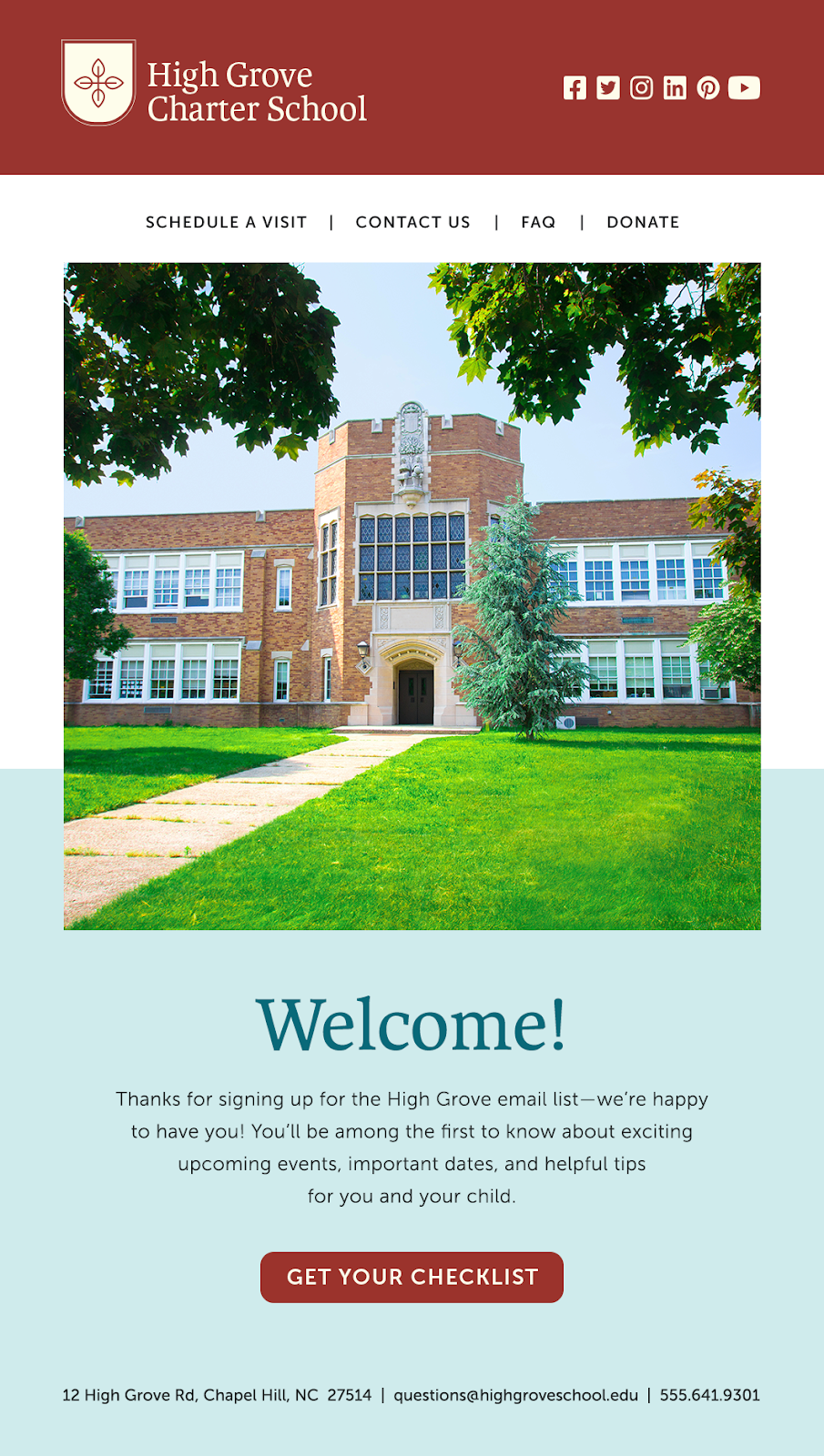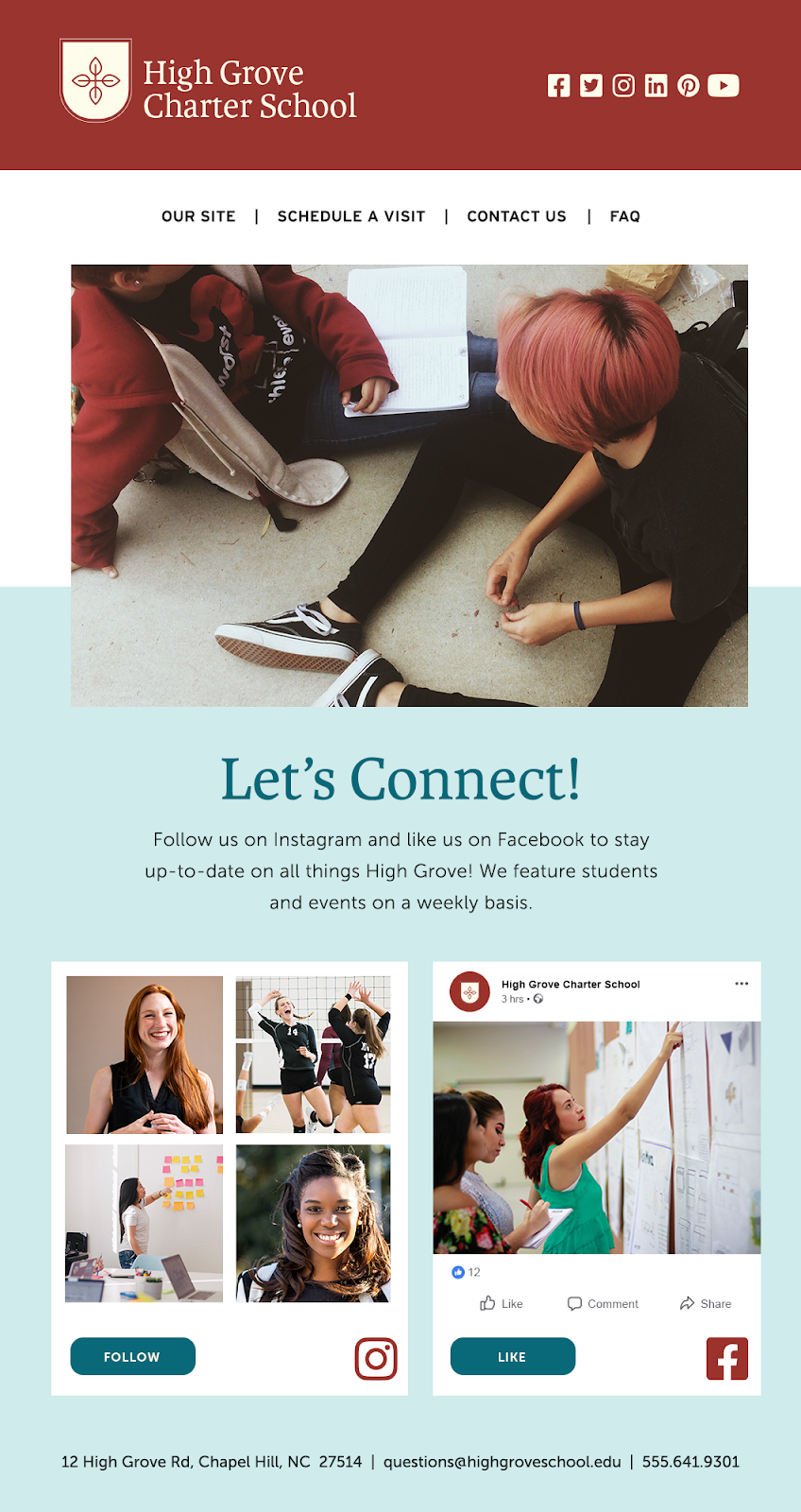
Email marketing is still one of the best ways you can connect with your community, alumni, and engage prospective parents and students – yes, even now.
I’m a huge advocate of strategically-designed email marketing campaigns for schools of all types. My school marketing agency, Kreative Webworks has been designing email marketing campaigns for educational institutions for years, and I can tell you that email marketing for school enrollments is effective.
When email marketing for schools is done right, the results can provide you with your biggest return on investment (ROI). Sure, it takes careful planning and a strategic understanding of your audience, but considering the value of even a single new enrollment, results are almost always worth the effort. Yet, many schools and universities don’t plan to invest time or marketing budgets to perfect their email campaigns.
If you’re looking to engage your community, have a constant stream of enrollment opportunities, and reach out to alumni for important donations so your institution can go from good to great, then email marketing is for you.
In this article, I’ll explain:
- Why education email marketing is necessary
- What you should include in your emails
- How often to send emails out
- What emails should be automated so you can be an email marketing pro and turn your school’s objectives into a reality
Why is email marketing necessary for schools?
You probably already have a sense that email marketing is an effective enrollment marketing strategy. However, many school leaders still don’t understand the real value that email marketing can have for their institutions.
Stay connected to students, families, and staff with expert marketing advice and all the tools you need, all in one place.
Virtually every business needs an effective way to communicate with current and new prospects. Think of your school like any other business – because that’s what it is.
It’s essential for a business to grow and optimize assets they already own. Assets like their website are a given. However, a well-curated and segmented contact list is another asset you own, and it can be solid gold if you leverage it properly.
You know those terms and conditions you’re supposed to read when you sign up for a new social media account? Well, one major condition included in that “legalese” is that you don’t own your account or any of the content you post. Should Facebook or Instagram shut down tomorrow – if that’s your main source of communication, you could be out in the cold…with absolutely no recourse.
That doesn’t mean you should ignore all other channels that you don’t own, as social media can be a useful tool to connect and show prospective students or parents your school’s culture. It should just be one of the many tools in your toolbox.
When someone gives you coveted access to their inbox, that means they are interested to learn more and want to engage with you. If a prospective parent or student provides you with their contact information – it screams tell me more!
According to statistica, people check their emails between 1 and 15 times per day, which is great news for any school or business that takes the time to cultivate a segmented email list and strategically “work the list”.
Now let’s get to the nitty-gritty….
TIP: Read my article Education Marketing 101 for more tips and a free guide to online education marketing.
What should I send in my marketing emails?
Before we get into the content of what you should send in your marketing emails, it’s important that you segment your contact lists.
This means creating unique categories based on interests and/or goals for your contacts. Some common segments you might create include:
- Prospective students
- Prospective parents
- Current students
- Current Parents
- Alumni
Each segment should consist of a series of emails that are tailored to their interests. Remember it’s not about what you think is interesting, but rather what your audience thinks is interesting. If your email doesn’t add value to them, you’re just methodically becoming a pest.
A good place to start is a welcome email after someone subscribes to your list. With a welcome email, do as you promise and welcome the subscriber. Let them know what they should expect by subscribing.

TIP: Wondering how to collect email addresses in the first place? One good way to grow your email list is with a sign-up form on your website. Learn what else should be included in a school or university website.
A few days later you can send an “invitation to connect” email where you invite your new subscriber to engage with you in other ways such as following your social media accounts, watching a video about your school, or eventually an invitation to an open house or school tour.

Other ideas for education email marketing campaigns:
- National holidays or made-up holidays (Get our free online marketing calendar for ideas)
- School announcements or updates
- Special events
- Helpful resources
The possibilities are endless, but whatever you decide, keep your emails personalized. You can do this by automatically inserting the subscriber’s first name, which you should already have from when they subscribed to your email list.
Also, include a call to action that matches your content such as ‘enroll now,’ ‘book a tour,’ or ‘join us for our open house.’ That way, your subscriber is left with a tangible action to take next.
Think of it as guiding them along their journey.
How often should I email my subscribers?
If you were expecting a specific answer, then prepare to be disappointed. Ultimately, how often you email subscribers depends on your objectives and what you want to achieve. It depends on who you are reaching out to and what you want to gain from your email marketing efforts.
For example:
If your email series is for prospective parents, then every three to four days for one month might be suitable since you want to create a subtle sense of urgency and stay top of mind as they are selecting schools.
Once you find a frequency that works, make sure you stay consistent whether it’s twice a month or once a month to touch base. Just remember that consistency is key.
Think about how often you would like to be reached out to. You don’t want to wear out your welcome to the point where your subscribers dread seeing your name in their inbox.
The number one reason people unsubscribe from emails is that they get them too often from the same sender. So, err on the side of caution as you can always ramp up frequency once you see how your subscribers respond.
When you feel like you’ve arrived at a frequency that works for your subscribers and your school, it’s time to optimize the content of your emails. Experiment a little… A/B test (compare the content on different emails to see which get the more favorable response).
What types of emails should I automate?
The simple answer is – most! Automation makes a huge impact on your school as it gives you the ability to focus your attention on what’s important that can’t be automated.
Automation means optimization, especially when it comes to email marketing. For many schools, the cracks in the marketing funnel start to appear in the recruitment phase and get deeper as they move through, which has a direct impact on enrollment.
To prevent families from slipping through the cracks, turn to marketing automation to keep them informed and engaged during their school selection process.
Since automated emails are triggered based on a user’s action, here are some different types of automated emails you can send:
- Welcome emails
- Information after filling out an online admissions form
- Follow-ups based on email opens and clicks
- Special events
- Alumni reach out
- Lead magnet follow up
- Re-engage lapsed applications
The email campaigns you choose to automate are entirely up to you. Automation is meant to make your life easier…work smarter not harder.
Final thoughts
Email marketing for education can be an invaluable tool to meet your enrollment numbers and ensure an engaged community. When you get to the root of it, it’s about delivering the right information to the right people and encourage them to take the action you want them to take.
If you would like to learn more about enrollment marketing for schools, grab my Guide to Enrolling More Students, and be automatically signed up for…you guessed it, my school marketing email tips.
source https://blogs.constantcontact.com/your-education-email-marketing-guide/
No comments:
Post a Comment